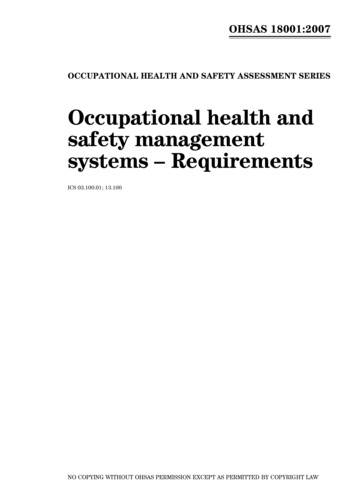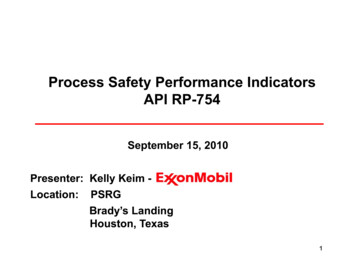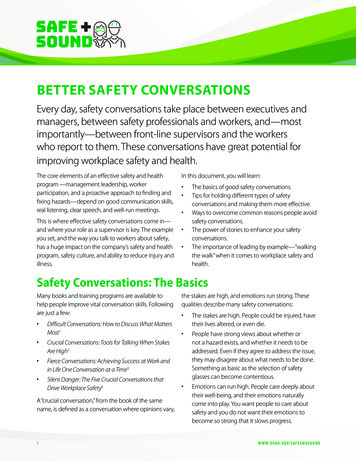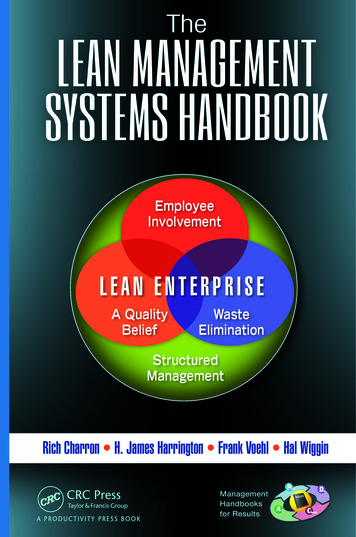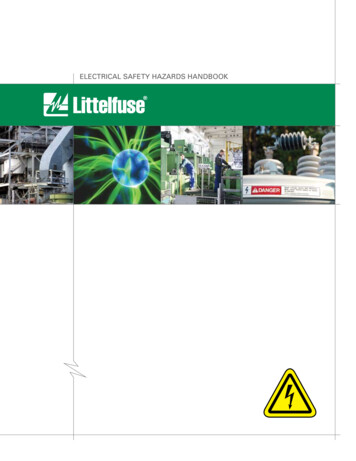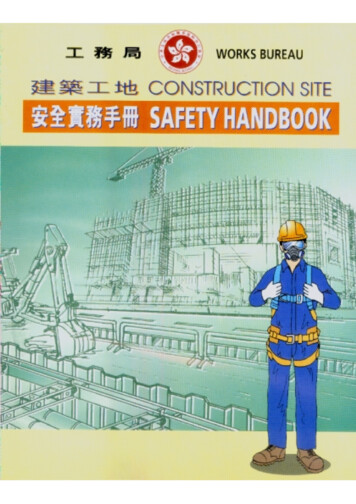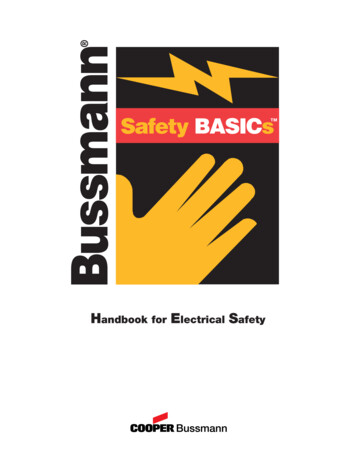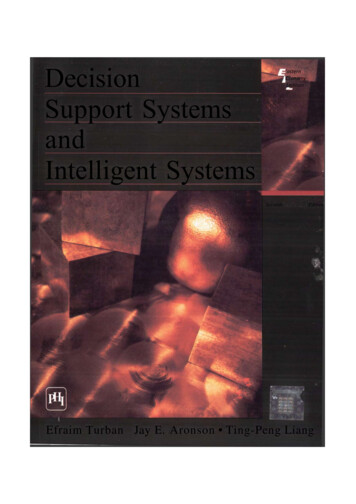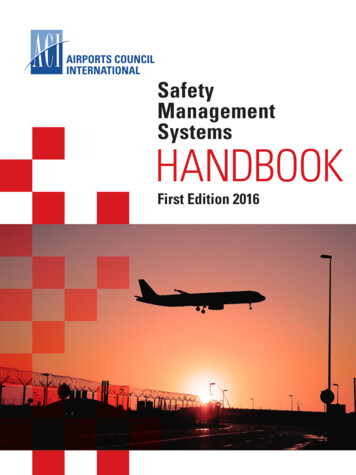
Transcription
SafetyManagementSystemsHANDBOOKFirst Edition 2016
SafetyManagementSystemsHANDBOOKFirst Edition 2016Authors:ACI World Safety and Technical Standing CommitteeWritten by:Warren Askew (GTAA), Li Ma Bomholtz (Copenhagen), John Chase (San Antonio),Thomas Christensen (Copenhagen), Carol Kavish (GTAA), Jason McArthur (YVR), TimO’Krongley (San Antonio), Nahla Palmer (YVR)Reviewed by:ACI World Safety and Technical Standing CommitteePublished by:ACI World, Montréal, CanadaFront and back cover photo courtesy of Arne V. Petersen
DISCLAIMERThe information contained in this publication is subject to constant assessment in the light of changingrequirements and regulations. No subscriber or other reader should act on the basis of any such informationwithout referring to applicable laws and regulations and/or without obtaining appropriate professionaladvice. Although every effort has been made to ensure accuracy, Airports Council International (ACI) shallnot be held responsible for loss or damage caused by errors, omissions, misprints or misinterpretationof the contents hereof. Furthermore, ACI expressly disclaims all and any liability to any person, whethera purchaser of this publication or not, in respect of anything done or omitted, and the consequences ofanything done or omitted, by any such person through reliance on the contents of this publication.No part of the Safety Management Handbook may be reproduced, recast, reformatted or transmittedin any form by any means, electronic or mechanical, including photocopying, recording or use of anyinformation storage and retrieval system, without prior written permission from:Director, Safety and Technical AffairsAirports Council InternationalSafety Management Systems HandbookFirst Edition (2016)Copies of this publication are available from:Publications DepartmentAirports Council InternationalP.O. Box 302800 Rue du Square VictoriaMontréal, CanadaEmail: aci@aci.aeroWeb: www.aci.aeroISBN 978-1-927907-42-9 2016 Airports Council International. All rights reserved.ii
FOREWORDThe idea of an ACI guidance handbook on Safety Management Systems (SMS)emerged from discussions in the Safety and Technical Standing Committee.ACI had already published an SMS Gap Analysis Tool and a chapter on SMS inthe Airside Safety Handbook, and wished to follow up by producing an actionorientated guide on SMS for aerodrome operators. Members of the committeedeveloped a table of contents and wrote and sourced material, including bestpractices from both inside and outside the aviation industry. We especiallyacknowledge the ICAO materials that are referenced.The handbook now before you is a useful summary of the action that aerodrome operators should taketo develop an SMS. This can never be an “off-the-shelf” system because, in order to function properly,such a system must be fully tailored to the circumstances of the individual aerodrome.We sincerely hope that this handbook will help our members to produce better, more appropriate,responsive and interactive SMS.As a complement to this handbook, ACI Global Training offers safety management training along with arange of courses relevant to safety, both online and in the classroom.I commend the handbook to you, and thank its authors for giving so generously of their time and expertise.Angela GittensDirector GeneralACI Worldiii
CONTENTSINTRODUCTION2STEP A (PLAN)ESTABLISH A SAFETY MANAGEMENT FRAMEWORK4SMS Element A1: RESPONSIBILITY4SMS Element A2: SMS IMPLEMENTATION (Organization, policy and processes)4STEP B (DO)IMPLEMENT SAFETY RISK MANAGEMENT12SMS Element B1: HAZARD IDENTIFICATION AND RISK MITIGATION12SMS Element B2: MANAGEMENT OF CHANGE18SMS Element B3: INCIDENT REPORTING AND INVESTIGATION20SMS Element B4: COORDINATION OF EMERGENCY RESPONSE PLANNING27STEP C (CHECK)EVALUATE ACHIEVEMENTS THROUGH SAFETY ASSURANCE28SMS Element C1: SAFETY PERFORMANCE MONITORING29SMS Element C2: SAFETY SURVEY35SMS Element C3: AUDIT36SMS Element C4: SAFETY RECORD-KEEPING44STEP D (ACT)CONTINUOUS IMPROVEMENT THROUGH SAFETY PROMOTION46SMS Element D1: TRAINING AND EDUCATION46SMS Element D2: SAFETY COMMUNICATION48REFERENCES51DEFINITIONS52ANNEXES531
INTRODUCTIONAccording to ICAO Annex 14, it is mandatory for a certified aerodrome to have a Safety ManagementSystem (SMS). This is a standard for aerodromes used for international operations and is recommendedthat it should also apply to aerodromes open to public use for domestic operations.Ref: ICAO Annex 14 Standard 1.4.41.4.4 As part of the certification process, States shall ensure that an aerodrome manual which willinclude all pertinent information on the aerodrome site, facilities, services, equipment, operatingprocedures, organization and management including a safety management system, is submittedby the applicant for approval/acceptance prior to granting the aerodrome certificate.Note.— The intent of a safety management system is to have in place an organized and orderlyapproach in the management of aerodrome safety by the aerodrome operator. Annex 19 — SafetyManagement contains the safety management provisions applicable to certified aerodromes.Guidance on an aerodrome safety management system is given in the Safety Management Manual(SMM) (Doc 9859) and in the Manual on Certification of Aerodromes (Doc 9774).1.0 Purpose: This handbook should be of interest to airport managers and others responsible for preparingand implementing SMS at their airports. It provides a reference based on ICAO SMS principles but it isspecifically adapted to the aerodrome-operator domain. The handbook will help the user understand whatconstitutes an airport SMS. It describes the components of an SMS and their interactions and offersguidance in the planning, implementation, and operation of an airport SMS. It also provides detailedinformation on how to carry out each of the necessary SMS steps. This handbook provides an overview ofSMS and explains how a systems approach to safety management can benefit both the safety operationsand the business activities of airports.1.1 The handbook outlines the methods used to support the implementation of SMS principles by: 2Step 1 (PLAN): Establish a safety management framework;Step 2 (DO): Implement safety risk management;Step 3 (CHECK): Evaluate achievements through safety assurance;Step 4 (ACT): Continuous improvement through safety promotion; andAnnexes: Best practices of airports.
1.2 General: This handbook is organized according to the four components and 12 elements of SMSidentified by ICAO.Ref: ICAO Annex 19 Appendix 2 Framework for a Safety Management SystemThis appendix specifies the framework for the implementation and maintenance of an SMS. Theframework comprises of four components and 12 elements as the minimum requirements forSMS implementation.a. Safety policy and objectivesi. Management commitment and responsibilityii. Safety accountabilitiesiii. Appointment of key safety personneliv. Coordination of emergency response planning (accident and incident investigation)v. SMS documentationb. Safety risk managementi. Hazard identificationii. Safety risk assessment and mitigationc. Safety assurancei. Safety performance monitoring and measurementii. The management of changeiii. Continuous improvement of the SMSd. Safety promotioni. Training and educationii. Safety communication3
STEPA(PLAN)AESTABLISH A SAFETY MANAGEMENT FRAMEWORKSMS Element A1 RESPONSIBILITY Airport management is responsible for taking the lead in adopting, implementing andenforcing all safety policies and procedures within the SMS Manual with the accountableexecutive having the overall responsibility of the SMS. Supervisors are responsible for ensuring that all employees understand and carry out theprocedures outlined in the SMS Manual. Each employee:a. has a major responsibility to ensure their personal safety and that of their fellow employees;b. must comply with the SMS Manual and all applicable administrative publications;c. must report all unsafe conditions or acts to their immediate supervisor upon detecting suchconditions; andd. must report all accidents immediately to their immediate supervisor or to the next highestsupervisor if their immediate supervisor is not available. Failure to comply with SMS Manual procedures may result in disciplinary action.SMS Element A2 SMS IMPLEMENTATION (Organization, policyand processes)Implementing an SMS requires a four-phase approach, with each phase building on the previous phase.SMS implementation flowEstablishment of basic plan and assignment of responsibilitiesDevelopment of safety management processEstablishment of safety risk management processImprovement of safety management systemFigure 1: SMS Implementation Flow4
Step A 2.1: Establishment of basic plan and assignment of responsibilitiesThe objective of the SMS implementation is to provide a blueprint of how the SMS requirements will bemet and integrated into the organization’s control systems, as well as an accountability framework for theimplementation of the SMS. During this phase, basic planning and assignment of responsibilities areestablished. This phase can take about 12 months to complete. During this initial phase, the aerodromeneeds to:Aa) Identify the SMS accountable executive: No safety management system will functioneffectively unless an “accountable executive” has ultimate authority to manage anddelegate resources to implement the SMS. It is important to understand the conceptof the accountable executive, because it is one of the primary elements of a successfulSMS. An SMS is different from other safety programmes because it holds each individualresponsible for safety. Each management official has the authority to establish policies andprocedures, and to allocate and direct resources within his or her division(s). This means thatthe responsibility for safety in each division must be accepted by the management of thatdivision. There should be a letter appointing the accountable executive and this should bemade available to all aerodrome employees. This will help set the stage for what comes next.The three most important roles of the accountable executive are:i. Visibly and actively promoting implementation of the SMS and requiring activeparticipation by all employees;ii. Creating an organizational structure, with designated positions and responsibleindividuals, that supports the Safety Management System, andiii. Providing both human and financial resources.b) Establish an SMS implementation team: This team should be comprised of representativesfrom the relevant departments/divisions. The members of this team should drive implementationof the SMS from beginning to end. The accountable executive should also appoint a personto be the “SMS manager.” This manager’s main role is to be the project manager for SMSimplementation. This individual should have a good understanding of management principles,as well as functional knowledge of the aerodrome’s operational activities. It is advantageousfor this person to have good communications skills, as well as to have won respect andrecognition within the organization, since most of the job will be to promote the SMS withfront-line personnel and middle management, and to obtain resources and support from topmanagement. This person must also have a solid understanding of the SMS.The SMS implementation team needs specialized SMS training in order to have a betterunderstanding of implementation of the SMS. Here are some examples of relevant training:i.ii.iii.iv.v.Introduction to safety managementHazard trainingHuman factorsRoot cause analysisRisk management5
Ac) Define the scope of the SMS: The SMS implementation team will have to come togetherto define the activities within the departments/divisions to which the SMS will be applicable.However, to set a “just culture” (safety culture) in motion, the SMS should be applicable toevery department/division.d) Perform an SMS gap analysis: The main function of the initial phase is the SMS gapanalysis. This analysis compares the service provider’s existing safety managementprocesses and procedures with requirements contained in the SMS framework. The gapanalysis facilitates development of an SMS implementation plan by identifying the gaps thatmust be addressed to implement an SMS fully. In ICAO Doc 9859, Third Edition 2013,Appendix 7 to Chapter 5, there is a checklist which will guide the implementation team inperforming the gap analysis. However, this checklist is not all-inclusive: the members of theSMS implementation team may have to add to the gap analysis additional areas which pertainto their respective areas of expertise.GAPPhase 1ExperiencebasedAirsideoperationalsafety proceduresCase andreports studyGAPPhase 2DatabasedDatacategorizationand comparisonGAPPhase 3ManagingsafetyGap completionFigure 2: Steps of SMS gap analysisStep A2.2: Development of safety management processThe objective is to implement all essential safety management processes. This phase consolidates intothe SMS the aerodrome’s existing safety activities and develops those additional safety activities whichmay have been identified by the SMS gap analysis. In this phase, the accountable executive, SMS managerand SMS implementation team develop safety policy and objectives, establish the SMS committee andwrite the SMS Manual and procedures. This phase can take about 12 months to complete.6
Safety policy and objectives:a) Binding these components and elements together contributes to developing a positive safety/just culture in the aerodrome organization. With an effective SMS programme it will be easierfor the aerodrome to develop a positive safety culture.b) Management must define the safety standards and polices for the aerodrome organization,encouraging participation in the SMS process, facilitating the flow of information, and supportingsafety objectives by allocating the required resources.c) The safety policy is management’s vehicle to c
Management Systems HANDBOOK First Edition 2016. ii DISCLAIMER The information contained in this publication is subject to constant assessment in the light of changing requirements and regulations. No subscriber or other reader should act on the basis of any such information without referring to applicable laws and regulations and/or without obtaining appropriate professional advice. Although .
